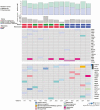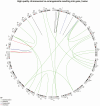Whole-genome Sequencing of Follicular Thyroid Carcinomas Reveal Recurrent Mutations in MicroRNA Processing Subunit DGCR8
- PMID: 34171097
- PMCID: PMC8530729
- DOI: 10.1210/clinem/dgab471
Whole-genome Sequencing of Follicular Thyroid Carcinomas Reveal Recurrent Mutations in MicroRNA Processing Subunit DGCR8
Abstract
Background: The genomic and transcriptomic landscape of widely invasive follicular thyroid carcinomas (wiFTCs) and Hürthle cell carcinoma (HCC) are poorly characterized, and subsets of these tumors lack information on genetic driver events.
Objective: The aim of this study was to bridge this gap.
Methods: We performed whole-genome and RNA sequencing and subsequent bioinformatic analyses of 11 wiFTCs and 2 HCCs with a particularly poor prognosis, and matched normal tissue.
Results: All wiFTCs exhibited one or several mutations in established thyroid cancer genes, including TERT (n = 4), NRAS (n = 3), HRAS, KRAS, AKT, PTEN, PIK3CA, MUTYH, TSHR, and MEN1 (n = 1 each). MutSig2CV analysis revealed recurrent somatic mutations in FAM72D (n = 3, in 2 wiFTCs and in a single HCC), TP53 (n = 3, in 2 wiFTCs and a single HCC), and EIF1AX (n = 3), with DGCR8 (n = 2) as borderline significant. The DGCR8 mutations were recurrent p.E518K missense alterations, known to cause familial multinodular goiter via disruption of microRNA (miRNA) processing. Expression analyses showed reduced DGCR8 messenger RNA expression in FTCs in general, and the 2 DGCR8 mutants displayed a distinct miRNA profile compared to DGCR8 wild-types. Copy number analyses revealed recurrent gains on chromosomes 4, 6, and 10, and fusion gene analyses revealed 27 high-quality events. Both HCCs displayed hyperploidy, which was fairly unusual in the FTC cohort. Based on the transcriptome data, tumors amassed in 2 principal clusters.
Conclusion: We describe the genomic and transcriptomic landscape in wiFTCs and HCCs and identify novel recurrent mutations and copy number alterations with possible driver properties and lay the foundation for future studies.
Keywords: cancer; carcinoma; follicular; mutation; thyroid; whole-genome.
© The Author(s) 2021. Published by Oxford University Press on behalf of the Endocrine Society.
Figures








References
-
- Bray F, Ferlay J, Soerjomataram I, Siegel RL, Torre LA, Jemal A. Global cancer statistics 2018: GLOBOCAN estimates of incidence and mortality worldwide for 36 cancers in 185 countries. CA Cancer J Clin. 2018;68(6):394-424. - PubMed
-
- James BC, Aschebrook-Kilfoy B, Cipriani N, Kaplan EL, Angelos P, Grogan RH. The incidence and survival of rare cancers of the thyroid, parathyroid, adrenal, and pancreas. Ann Surg Oncol. 2016;23(2):424-433. - PubMed
-
- Lloyd RV, Osamura RY, Klöppel G, Rosai J.. WHO Classification of Tumours of Endocrine Organs. WHO/IARC Classification of Tumours. 4th ed. Vol. 10. Lyon: International Agency for Research on Cancer; 2017.
Publication types
MeSH terms
Substances
LinkOut - more resources
Full Text Sources
Medical
Research Materials
Miscellaneous

